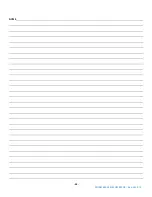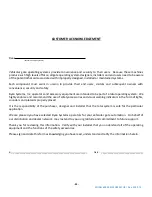
-45-
MODEL 600 SERIES OPERATOR | Rev. 2019.7.1
LOOP DETECTOR CONNECTIONS
The Mollex connector has 11 wire leads which are each 12 inches long. The pin-out is as follows:
RED
Power B+
BLACK
Power B-
BLUE
Relay A Common (pulse or presence)
ORANGE
Relay a Normally Closed (pulse or presence)
YELLOW
Relay A Normally Open (pulse or presence)
GREEN
Relay B Common (pulse only)
PURPLE
Relay B Normally Open (pulse only)
BROWN
Loop Wire
GRAY
Loop Wire
WHITE
Not Used
NOTE:
Leader wire from the loop, whether it is pre-formed or manufactured
on the installation site, MUST be twisted a minimum of five turns per
foot.
THE PROPER LOOP WIRE
Why is the loop wire so important?
One of the main causes of vehicle loop detector failures is the use of inferior wire types when constructing the
loop. Since moisture can cause a significant change in the dielectric constant of the insulation, which results in
excessive loop (frequency) drift, you must choose the wire with an insulation that is most impervious to
moisture. It is also important to choose a wire with a rugged, abrasion resistant insulation. Remember that all
pavements are porous and contain trapped moisture. Water or other chemicals will eventually reach the
insulation and either attack the insulation, be absorbed by it, or migrate through tiny cracks in the insulation
and change the dielectric or break down the insulation and cause shorts to ground.
What about the wire?
Polyvinyl chloride (PVC) insulation (TFFN, THHN, and THHN-THWN) should be avoided since it tends to absorb
moisture and cracks very easily. The insulation is thin and very soft, leaving it vulnerable to damage during
installation and rapid age cracking after sealing. Any one of the above-mentioned wire types has only 0.015
inch of insulation from 12 gauge to 18 gauge. If there is any doubt about its vulnerability, crimp the insulation
with a pair of pliers and see how it cracks. See how easily it strips with a pocketknife. What would an unnoticed
piece of wire or a shard of glass buried in the pavement slot do to the insulation? The outer diameter is 0.115
inch for 14 gauge wire and 0.013 inch for 16 gauge wire. When installed in a 0.25 inch slot and the turns twist
under the preceding turns and not stack snugly in a single layer, as they should be. This will cause reduced loop
efficiency.











































